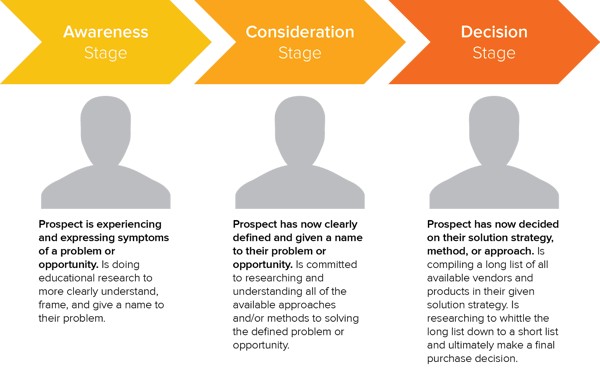What is a buyer journey?
Nobody wakes up in the morning and decides: “I’m going to buy something today” without knowing what it is. Instead, they first go through a purchase process of research and consideration.
What is the buyer journey?
Before people become customers, they go through several steps. They become aware of a problem and the need for a solution, consider the possibilities, evaluate the pros and cons and finally decide whether or not to go for it. This process is referred to as the buyer journey.
The buyer journey consists of three steps:
- Awareness stage
- Consideration stage
- Decision stage
Awareness stage
In the first phase of the buyer journey, your customer – also known as a buyer persona – realizes that they have a problem, often without defining the problem and with no immediate solution. They will orient themselves and look for information that matches their problem. In this phase, you want to be helpful. You offer information to show what options are available without immediately pushing your product forward.
For example: I want a clean house, but I don’t have the time or inclination to clean it myself.
Consideration stage
In the second phase, people dive deeper into the options. The buyer persona has defined their problem and is exploring options to solve it. This is where you introduce your options. Stay in the helpful role but show what options you offer and how they might help. In this way, the buyer persona arrives at several options from several companies.
For example: I could hire a cleaning company, buy a robot vacuum cleaner or ask someone else to help.
Decision stage
In the third phase, the buyer knows what solution they want and is looking for a provider. They will weigh up all the pros and cons to make the best choice. This is the time to put forward the added value of your company. Make it clear why they should choose you.
For example: I am going for a robot vacuum cleaner. Now I just have to choose what type and brand.

Defining the buyer journey for your business
Before you can start drawing up the buyer journey, you need to have a good picture of your (potential) customers. This is also referred to as the buyer persona. The buyer persona gives you insight into what kind of people your customers are and what motivates them.
Use the following questions with the buyer persona to put together the buyer journey for your company:
Awareness
During the awareness phase, buyers identify their challenges and decide whether the goal is a priority. To fully understand your buyer’s awareness phase, ask the following questions:
- How do buyers describe their problems, goals or challenges?
- How do buyers research the possible solutions?
- What are the consequences if the buyer does nothing?
- Are there common misconceptions about tackling the problem?
- How do buyers decide if tackling the problem should be prioritized?
Consideration
During the consideration phase, buyers have clearly defined the problem and are prepared to tackle it. They evaluate the different approaches or methods available to solve it. In this phase, you ask the questions:
- What kind of solutions are buyers researching? Which categories?
- How do buyers research the different categories?
- How do buyers see the pros and cons of each category?
- How do buyers decide which category suits them?
Decision
In the decision phase, buyers have already chosen a solution category. They have compared the pros and cons and decided which solution best suits their needs. The questions at this stage are:
- What criteria do buyers use to evaluate the available supply?
- When buyers examine your company’s offerings, what do they like about them compared to the alternatives? And what concerns do they have about your offering?
- Who should be involved in the decision? How does their perspective on the decision differ for each person involved?
- Do buyers have expectations about trying out the offering before they buy?
- Do buyers need to make additional preparations, such as implementation plans or training strategies?
The answers to these questions form a solid foundation for your company’s buyer journey.
If you want help with creating a buyer persona or the buyer journey, schedule a call with Ron for 30 minutes of advice, no strings attached.
You may also like
Who is this Buyer Persona?

Personalizing the Customer Journey with HubSpot Marketing Hub


